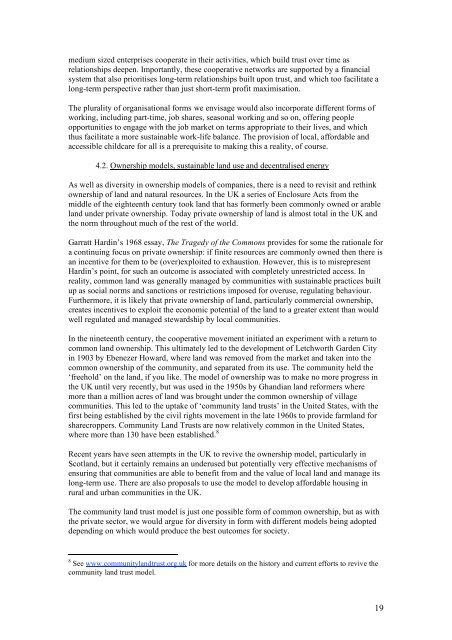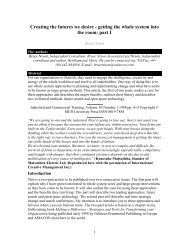From Old Economics to New Economics- Radical ... - Bruce Nixon
From Old Economics to New Economics- Radical ... - Bruce Nixon
From Old Economics to New Economics- Radical ... - Bruce Nixon
Create successful ePaper yourself
Turn your PDF publications into a flip-book with our unique Google optimized e-Paper software.
medium sized enterprises cooperate in their activities, which build trust over time as<br />
relationships deepen. Importantly, these cooperative networks are supported by a financial<br />
system that also prioritises long-term relationships built upon trust, and which <strong>to</strong>o facilitate a<br />
long-term perspective rather than just short-term profit maximisation.<br />
The plurality of organisational forms we envisage would also incorporate different forms of<br />
working, including part-time, job shares, seasonal working and so on, offering people<br />
opportunities <strong>to</strong> engage with the job market on terms appropriate <strong>to</strong> their lives, and which<br />
thus facilitate a more sustainable work-life balance. The provision of local, affordable and<br />
accessible childcare for all is a prerequisite <strong>to</strong> making this a reality, of course.<br />
4.2. Ownership models, sustainable land use and decentralised energy<br />
As well as diversity in ownership models of companies, there is a need <strong>to</strong> revisit and rethink<br />
ownership of land and natural resources. In the UK a series of Enclosure Acts from the<br />
middle of the eighteenth century <strong>to</strong>ok land that has formerly been commonly owned or arable<br />
land under private ownership. Today private ownership of land is almost <strong>to</strong>tal in the UK and<br />
the norm throughout much of the rest of the world.<br />
Garratt Hardin’s 1968 essay, The Tragedy of the Commons provides for some the rationale for<br />
a continuing focus on private ownership: if finite resources are commonly owned then there is<br />
an incentive for them <strong>to</strong> be (over)exploited <strong>to</strong> exhaustion. However, this is <strong>to</strong> misrepresent<br />
Hardin’s point, for such an outcome is associated with completely unrestricted access. In<br />
reality, common land was generally managed by communities with sustainable practices built<br />
up as social norms and sanctions or restrictions imposed for overuse, regulating behaviour.<br />
Furthermore, it is likely that private ownership of land, particularly commercial ownership,<br />
creates incentives <strong>to</strong> exploit the economic potential of the land <strong>to</strong> a greater extent than would<br />
well regulated and managed stewardship by local communities.<br />
In the nineteenth century, the cooperative movement initiated an experiment with a return <strong>to</strong><br />
common land ownership. This ultimately led <strong>to</strong> the development of Letchworth Garden City<br />
in 1903 by Ebenezer Howard, where land was removed from the market and taken in<strong>to</strong> the<br />
common ownership of the community, and separated from its use. The community held the<br />
‘freehold’ on the land, if you like. The model of ownership was <strong>to</strong> make no more progress in<br />
the UK until very recently, but was used in the 1950s by Ghandian land reformers where<br />
more than a million acres of land was brought under the common ownership of village<br />
communities. This led <strong>to</strong> the uptake of ‘community land trusts’ in the United States, with the<br />
first being established by the civil rights movement in the late 1960s <strong>to</strong> provide farmland for<br />
sharecroppers. Community Land Trusts are now relatively common in the United States,<br />
where more than 130 have been established. 8<br />
Recent years have seen attempts in the UK <strong>to</strong> revive the ownership model, particularly in<br />
Scotland, but it certainly remains an underused but potentially very effective mechanisms of<br />
ensuring that communities are able <strong>to</strong> benefit from and the value of local land and manage its<br />
long-term use. There are also proposals <strong>to</strong> use the model <strong>to</strong> develop affordable housing in<br />
rural and urban communities in the UK.<br />
The community land trust model is just one possible form of common ownership, but as with<br />
the private sec<strong>to</strong>r, we would argue for diversity in form with different models being adopted<br />
depending on which would produce the best outcomes for society.<br />
8 See www.communitylandtrust.org.uk for more details on the his<strong>to</strong>ry and current efforts <strong>to</strong> revive the<br />
community land trust model.<br />
19



